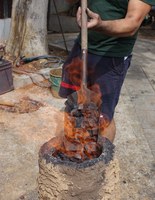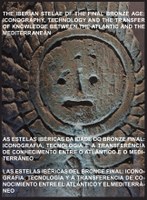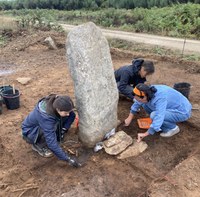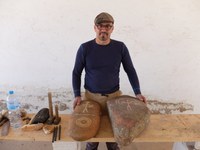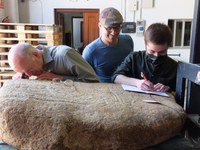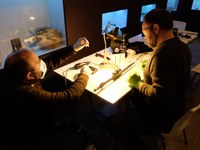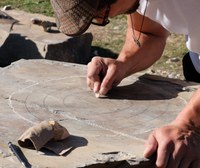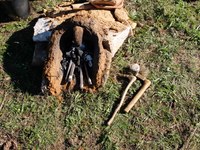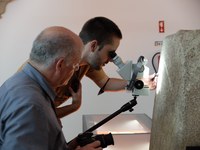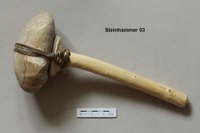The Project / O Projecto / El Proyecto / Das Projekt
The Iberian stelae of the Final Bronze Age: Iconography, Technology and the Transfer of Knowledge between the Atlantic and the Mediterranean
As estelas ibéricas da Idade do Bronze Final: iconografia, tecnologia e a transferência de conhecimento entre o Atlântico e o Mediterrâneo
Las estelas ibéricas del Bronce Final: iconografia, tecnología y a transferencia de conocimiento entre el Atlántico y el Mediterráneo
Die Iberischen Stelen der Spätbronzezeit: Bildkunst, Technologie und Wissenstransfer zwischen Atlantik und Mittelmeer
Funded by Deutsche Forschungsgemeinschaft DFG, Projektnummer: AR 1305/2-1
Stelae made of hard rock: 1. Baraçal 1, granite; 2. Brozas, gabbro; 3. Robledillo, granite; 4. Capilla 8, quartzite; 5. Capilla 1, quartzite; (1: courtesy of Raquel Vilaça, 2-5: photographs Ralph Araque).
Die archäologische Überlieferung der Spätbronzezeit auf der Iberischen Halbinsel (ca. 1300-800 v. Chr.) ist in vielen Regionen lückenhaft: es sind nahezu keine Gräber, nur spärliche Siedlungsreste und wenige Hortfunde sowie Bergbauspuren bekannt. Umso größer ist daher die Bedeutung der mit komplexen Bildwerken verzierten Iberischen Stelen, denn die Darstellungen von anthropomorphen Figuren, Tieren und Gegenständen sind eine einzigartige archäologische Quelle für die Untersuchung dieser Epoche. Dank jener Denkmäler sind nicht nur Bilder überliefert, die im sonstigen Befund unbekannte Objekte zeigen, sie liefern auch Hinweise auf spirituelle und ideologische Konzepte, die kognitiven Fähigkeiten der Künstler sowie Steinbearbeitungstechniken.
Das Kulturphänomen hatte nach aktuellem Forschungsstand seinen Ursprung in der Beira Interior in Portugal und in der Alta Extremadura in Spanien, wo seit der Kupferzeit eine lange Tradition von Statuen-Menhiren und Stelen bestand. Darum sollen dort umfassende Regionalstudien durchgeführt werden, welche eine Untersuchung zur diachronen und synchronen Entwicklung der Felskunst, Landschafts- und Materialanalysen sowie eine Ausgrabung vorsieht. Die Region fungierte durch die geografische Lage als Mittler zwischen dem Atlantik und dem Süden Iberiens. Die Stelen waren bald bis nach Andalusien verbreitet, und die Motive belegen Verbindungen zum Mittelmeerraum. Folglich sollen sie auch im überregionalen Rahmen als ein charakteristischer kultureller Ausdruck der iberischen Netzwerke untersucht werden.
Ca. 50% der bekannten Stelen sind in Hartgesteine wie Granit oder Quarzit gehauen. Die Bearbeitung solcher Materialien mit bronzezeitlichen Werkzeugen ist bislang ungeklärt. Es ist jedoch unerlässlich, zu verstehen wie die Stelen gemacht sind, um zu erkennen, warum die Symbole in Hartgestein gemeißelt wurden. In einem grundlegend neuen Ansatz sollen die Stelen als komplexe Bildträger untersucht werden, wobei die symbolträchtigen Bilder und das als Projektionsfläche genutzte Gesteinsmaterial sowie die Position in der Landschaft als untrennbare kognitive Einheit betrachtet werden.
Ziel des Forschungsvorhabens ist eine kohärente und systematische Untersuchung der Stelen in Hinblick auf ihre symbolische und gesellschaftliche Bedeutung, die handwerkliche Leistung der Künstler und das Netzwerk der interkulturellen Kommunikation zwischen atlantischen und mediterranen Regionen, das für einen kontinuierlichen Wissens- und Technologietransfer sorgte. Dies soll mit einem multidisziplinären Forscherteam und einem Instrumentarium welches digitale Dokumentation, Geo- und Materialwissenschaften, Petrologie, Experimentalarchäologie, Landschaftsanalyse (GIS), Netzwerkanalysen, Bildwissenschaften sowie kognitive und Sozialarchäologie umfasst, erreicht werden.

Summary English
The archaeological record of Late Bronze Age (LBA) Iberia (c. 1300-800 BC) is fragmentary in many areas: sparse remains of settlement and nearly no detectable burials are complemented by traces of metal hoarding and remains of mining activities. Taking this into account, the western Iberian stelae with their depictions of anthropomorphic figures, animals and selected objects are of unique importance for the investigation of this era. These monuments do not only show pictorial representations of artefacts otherwise unknown in the archaeological record, but they also represent spiritual and ideological concepts, the cognitive abilities of the artists, as well as the technical possibilities of stone-working.
According to recent research, this cultural phenomenon had its origins in the Beira Interior in Portugal and in the neighbouring Alta Extremadura, where statue-menhirs and stelae had a longstanding tradition from the Chalcolithic onwards. A regional in-depth study of this area, comprised of the diachronic and synchronic evaluation of rock art, landscape archaeology, materials analysis and excavation, shall therefore be conducted. The region functioned as a pivotal node between the Atlantic shores and the Mediterranean South of Iberia. The stelae were soon widespread in Extremadura and Andalusia, while they show obvious references to Mediterranean motifs. For this reason, the stelae will also be investigated in their cross-regional context as characteristic manifestations of the Iberian networks.
Almost 50% of all stelae have been carved into hard rock such as granite or quartzite. The carving of such materials with prehistoric technologies remains unexplained and unexplored. It is however essential to understand how the stelae were actually made to be able to interpret why the respective symbols were carved into hard rock. In a pioneering approach, the stelae will be studied as multifaceted image media by considering the depictions together with the materials used to screen the symbolic information and their positioning in the landscape as an inseparable cognitive unit.
The Iberian stelae could not be appropriately studied in their archaeological contexts since none of them so far have been found in situ. For the investigation of the vast majority of stelae, only interpretative drawings of the designs are available. These vary significantly from one publication to the next and generally ignore the rock type, structure, and mineralogy.It is the aim of this project to provide a deeper understanding of the communicative, socio-material meanings of stelae as manifestations of the advances and travels of craftspeople who were actors in the symbolic structuring of social realities in LBA Iberia. Due to the lack of analysis and technological studies, this research project will put emphasis on materials science, which will be complemented by experimental archaeology. Systematic material culture studies of ancient stone-working techniques are a desideratum of Bronze Age research, since the results will be implementable for any archaeological environment featuring rock art.
The main objective of this project is a comprehensive and systematic investigation of the stelae to provide insights into their symbolic and societal significance as well as information on the artists, their social roles, skills, technology transfer and the network of intercultural communications between the Atlantic and the Mediterranean that provided them with a flow of ideas and knowledge. This research will take into account the perspectives of masonry, craftsmanship and technology transfer that will be integrated into micro- as well as macro scale regional studies. The stelae will be examined as multifaceted image media, considering the materials used to screen the symbolic information of designs and their positioning in the landscape as inseparable cognitive units. This will significantly enhance the knowledge on supra-regional connectivity in the LBA as well as on the stelae’s role as a means of communication and on prehistoric strategies of visual communication through persistent symbolic complexes in general.
The project objectives will be achieved through multidisciplinary cooperation of the research group and an approach that encompasses digital recording, geoscience, petrology, materials science, experimental archaeology, landscape and network analysis, visual culture studies, cognitive and social archaeology. The combination of data from scientific analysis (geoscientific and metallurgical analyses) and landscape archaeology with visual and material culture studies is resulting in a broad interpretative framework.

Verbreitungskarte der spätbronzezeitlichen Stelen in Iberien und Südfrankreich.
Distribution map of LBA stelae in Iberia and southern France.
Mapa de las estelas del Bronce Final de la Península Ibérica y en el Sud de Francia.
Bibliography
Araque, R. 2018: Inter-cultural communications and iconography in the western Mediterranean during the Late Bronze Age and the Early Iron Age. Rahden 2018.
Armada et al. 2018: X.-L. Armada, M. Murillo-Barroso and Mike Charlton 2018. Metals, minds and mobility: Integrating scientific data with archaeological theory. Oxford 2018.
Armbruster, B. R. 2003: A metalurgia da idade do Bronze Final Atlântico do Castro de Nossa Senhora da Guia, de Baiões (S. Pedro do Sul, Viseu). Estudos Pré-Hisóricos X-XI, 2002-2003, 145-155.
Aubet, M. E. & P. Sureda (ed.) 2013: Interacción social y comercio en la antesala del colonialismo. Barcelona 2013.
Babbi et al. 2015: A. Babbi, F. Bubenheimer-Erhart, B. Marín-Aguilera & S. Mühl (ed.) The Mediterranean mirror: cultural contacts in the Mediterranean Sea 1200-750 BC. Mainz 2015.
Baptista, P. 2019: Mobilidade Humana nos Territórios da Beira Interior Durante o Bronze Final. Estudos Pré-históricos, 19. Viseu 2019.
Baptista, P. 2020: Entre o digital e o humano no estudo da mobilidade: o caso do Bronze Final na Beira Interior (Centro de Portugal). In Vilaça, R.; Aguiar, R. (eds.): (I)mobilidades na Pré-história. Pessoas, recursos, objetos, sítios e territórios. Coimbra 2020, 223-253.
Bartelheim, M. 2007: Die Rolle der Metallurgie in vorgeschichtlichen Gesellschaften / The Role of Metallurgy in Prehistoric Societies. Rahden 2007.
Bottaini, C. 2013: Final Bronze Age (13th-7th cent. BC) Hoards in the Center and North of Portugal. Social and archaeometallurgy aspects. Unpublished PhD thesis, University of Coimbra, supervised by Prof. Dr. R. Vilaça 2013.
Brandherm, D. 2007: Las espadas del Bronce Final en la Península Ibérica y Baleares. PBF IV, 16. Stuttgart 2007.
-2013: Mediterranes, Atlantisches und Kontinentales in der bronze- und ältereisenzeitlichen Stelenkunst der Iberischen Halbinsel, in G. Kalaitzoglou & G. Lündorf (ed.) Petasos – Festschrift für Hans Lohmann. Paderborn 2013, 132-48.
Bucher, K. & M. Frey 1994: Petrogenesis of metamorphic rocks. Berlin & New York 1994.
Celestino, S. 2001: Estelas de guerrero y estelas diademadas. La Precolonización y formación del mundo tartésico. Barcelona 2001.
Celestino et al. 2012: S. Celestino, V. Mayoral Herrera, J. A. Salgado Carmona & R. Cazorla Martín: Stelae Iconography and the Landscape in the Southwest of the Iberian Peninsula, in Moore & Armada 2012, 135-52.
Celestino, S. and E. Rodríguez (ed.) 2017: Territórios comparados: los valles del Guadalquivir, el Guadiana y el Tajo en época tartésica. Anejos del Archivo Español de Arqueología 80, Mérida 2017.
Díaz-Guardamino, M. 2010: Las Estelas decoradas en la Prehistoria de la Península Ibérica. Madrid: Universidad Complutense, http://eprints.ucm.es/11070/ (accessed November 2015).
Díaz-Guardamino, M. and D. Wheatley 2013: Rock Art and digital technologies: The Application of reflectance Transformation Imaging (RTI) and 3D Laser Scanning to the study of Late Bronze Age Iberian Stelae. MENGA Revista de Prehistoria de Andalucía 4, 187-203.
Díaz-Guardamino et al. 2015: M. Díaz-Guardamino, L. García Sanjuán, D. Wheatley and Víctor Rodríguez Zamora 2015. RTI and the study of engraved rock art: A re-examination of the Iberian south-western stelae of Setefilla and Almadén de la Plata 2 (Seville, Spain). Digital Applications in Archaeology and Cultural Heritage 2 (2015), 41-54.
Díaz-Guardamino et al. 2019a: M. Díaz-Guardamino, L. García-Sanjuán, D. Wheatley, J.A. Lozano-Rodríguez, M. Á. Rogerio-Candelera & M. Casado-Ariza 2019. Late Prehistoric Stelae, Persistent Places and Connected Worlds: A Multi-disciplinary Review of the Evidence at Almargen (Lands of Antequera, Spain). Cambridge Archaeological Journal, https://doi.org/10.1017/S0959774319000490
Díaz-Guardamino et al. 2019b: M. Díaz-Guardamino, L. García-Sanjuán, D. Wheatley, J.A. Lozano-Rodríguez, M. Á. Rogerio-Candelera, Mi. Krueger, Ma. Krueger, M. Hunt Ortíz, M. Murillo-Barroso, V. Balsera Nieto 2019. Rethinking Iberian ‚warrior’ stelae: a multidisciplinary investigation of Mirasiviene and ist connection to Setefilla (Lora del Río, Seville, Spain). Archaeological and Anthropological Sciences (2019) 11: 6111-6140.
Dominguez de la Concha et al. 2005: C. Dominguez de la Concha, J. M. González Bornay &J. de Hoz Bravo, Catálogo de estelas decoradas del Museo Arqueológico Provincial de Badajoz, siglos VIII-V a.C. Badajoz 2005.
Enríquez Navascués, J. and M. Fernández Algaba 2010: Notas sobre las técnicas de grabado y de composición formal de las estelas diademadas y de guerreros. Cuadernos de Arquéologia Universidad de Navarra 18, 149-175.
Fábrega et al. 2011: Fábrega Álvarez, P. Fonte, J. and González García, F. J. Las sendas de la memoria. Sentido, espacio y reutilización de las estatuas-menhir en el noroeste de la Península Ibérica. Trabajos de Prehistoria 68 (2), 313-330.
Figuereido et al. 2010: E. Figuereido, R. J. C. Silva, J. C. Senna-Martinez, M. F. Araujo, F. M. Braz Fernandez & J. L. Inez Vaz 2010. Smelting and recycling evidences from the Late Bronze Age habitat site of Baioes (Viseu, Portugal). Journal of Archaeological Science 37, 1623-1634.
Frey M. & Robinson D. (eds.) 1999: Low-grade metamorphism. Blackwell Science, Oxford 1999.
García Sanjuan et al. 2006: L. García Sanjuán, D. W. Wheatley, P. Fábrega Álvarez, A. M. Hernández Arnedo & A. Polvorinos del Río 2006. Las estelas de guerrero de Almadén de la Plata (Sevilla). Morfología, technologiá y contexto. Trabajos de Prehistoria 63 (2), 135-152.
Gutierréz Sáez et al. 2020: Gutierréz Sáez, C., P. Muñoz Moro, J. Pereira, T. Chapa Brunet 2020. Las estelas de guerrero del valle medio del Tajo. Recreación experimental del proceso de elaboración / The warriors stelae of the Middle Valley of the Tagus. Experimental recreation of the elaboration process. Anejos a CuPAUAM 4, 2020, 93-104.
Harrison, R. J. 2004: Symbols and warriors. Images of the European Bronze Age. Bristol 2004.
Huth, C. 2003: Menschenbilder und Menschenbild. Anthropomorphe Bildwerke der fruhen Eisenzeit. Berlin 2003.
Ling et al. 2014: Ling, J., Z. Stos-Gale, L. Grandin, K. Billström, E. Hjärthner-Holdar, P.-O. Persson 2014. Moving metals II: provenancing Scandinavian Bronze Age artefacts by lead isotope and elemental analyses. Journal of Archaeological Science 41, 106-132.
Llobera et al. 2011: Llobera, M., P. Fábrega Álvarez & C. Parcero Oubiña 2011. Order in movement: a GIS approach to accessibility. Journal of Archaeological Science 38, 843-851.
Lo Schiavo, F. 2013: Interconnessioni fra Mediterraneo e Atlantico nell’Età de Bronzo: Il punto di vista della Sardegna, in: Aubet & Sureda 2013, 107-134.
Lull et al. 2014: V. Lull, R. Micó, C. Rihuete Herrada & R. Risch 2014. The Bronze Age in Mediterranean Iberia, in M. Almagro Gorbea (ed.) Iberia. Protohistory of the Far West of Europe: From Neolithic to Roman Conquest. Burgos 2014, 127-46.
Le Maître, R. W. (ed.) 2004: Igneous Rocks. A Classification and Glossary of Terms. Cambridge 2004.
Merino Martínez et al. 2019: E. Mereino Martínez, P. Andonaegui, T. Chapa & J. Pereira Sieso 2019: Petrographic and geochemical study of the stone warrior stelae from central Iberia: Linking the geological record and archaeological heritage. Geoarchaeology. 2019, 1-21.
Moore, T. & X.L. Armada 2012: Atlantic Europe in the First Millenium BC - crossing the divide. Oxford 2012.
Pavón Soldevilla, I. 1998: El Tránsito del II al I Milenio a. C. en las Cuencas medias de los rós Tajo y Guadiana: La Edad del Bronce. Cáceres 1998.
Rodriguez-Corral, J. 2017: Entangled worlds: materiality, archaeometry and mediterranean-atlantic identities in Western Iberia. Mediterranean Archaeology and Archaeometry 17 (1), 159-178.
Ruiz-Gálvez Priego, M. 1995: Ritos de Paso y Puntos de Paso: La Ría de Huelva en el mundo del Bronce Final Europeo. Madrid 1995.
Senna-Martinez et al. 2011: J.C. Senna-Martinez, E. Figueiredo and M.F. Araújo 2011: Metallurgy and Society in ‘Baioes/Santa Luzia’ Culture Group: results of the metal bronze project, in: C.B. Martins, A. Bettercourt, J. Martins and J. Carvalho (eds.) Primer Congreso Internacional Povoamento e Exploração de Recursos Mineiros na Europa Atlântica Ocidental. Braga, 405-420.
Vilaça, R. 1995: Aspectos do Povoamento da Beira Interior (Centro e Sul) nos finais da Idade do Bronze. Lisbon.
- 2004: O Monte do S. Martinho, Castelo Branco, na Idade de Bronze, in: A. M. Ferreira & M. E. Rodrigues (ed.), Arqueologia: collecções de Francisco Tavares Proença Júnior. Castelo Branco 2004, 54-61.
- 2007: Depósitos de Bronze do território Português. Um debate um aberto. Coimbra 2007.
- 2011 (ed.): Estelas e estátuas-menires da Pré à Proto-história. Sabugal 2011.
- 2013a: L’arrivée des premiers fers dans l’Occident atlantique. Dossier les transferts de technologie au premier millenaire av. J.-C., Mélanges de la Casa Velázquez 43 (1), 39-64.
- 2013b: Late Bronze Age: Mediterranean Impacts in the Western End of the Iberian Peninsula (Actions and Reactions), in Aubet & Sureda 2013, 13-41.
Vilaça, R. & J. Cardoso 2017: O Tejo português durante o Bronze Final, in: Celestino & Rodríguez 2017, 237-281.
Vilaça, R. & M. Osório 2017: Os Mapas do Poder no raiar do I milénio a.C. Estelas de guerreiro, filões mineiros e recursos geológicos da Beira Interior (Centro de Portugal) como caso de estudo, in: A. Baratas Díaz, F. Barroso-Barcenilla & P. Callapez (eds.) Los mapas de la naturaleza/Os mapas da natureza. Madrid 2017, 444-446.



